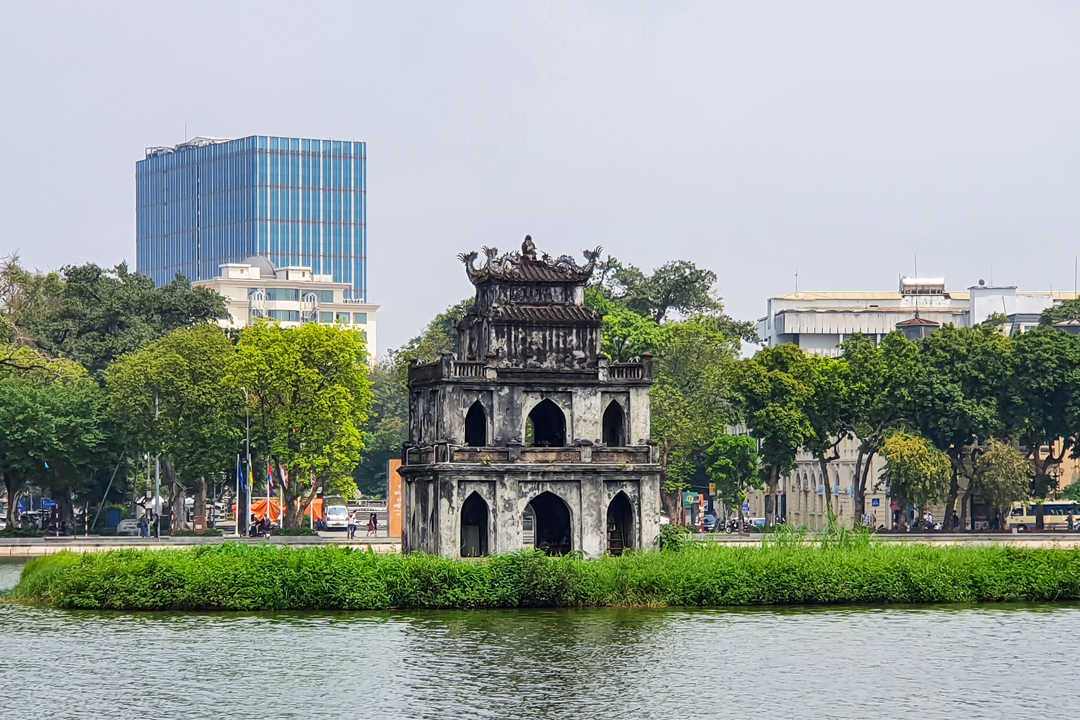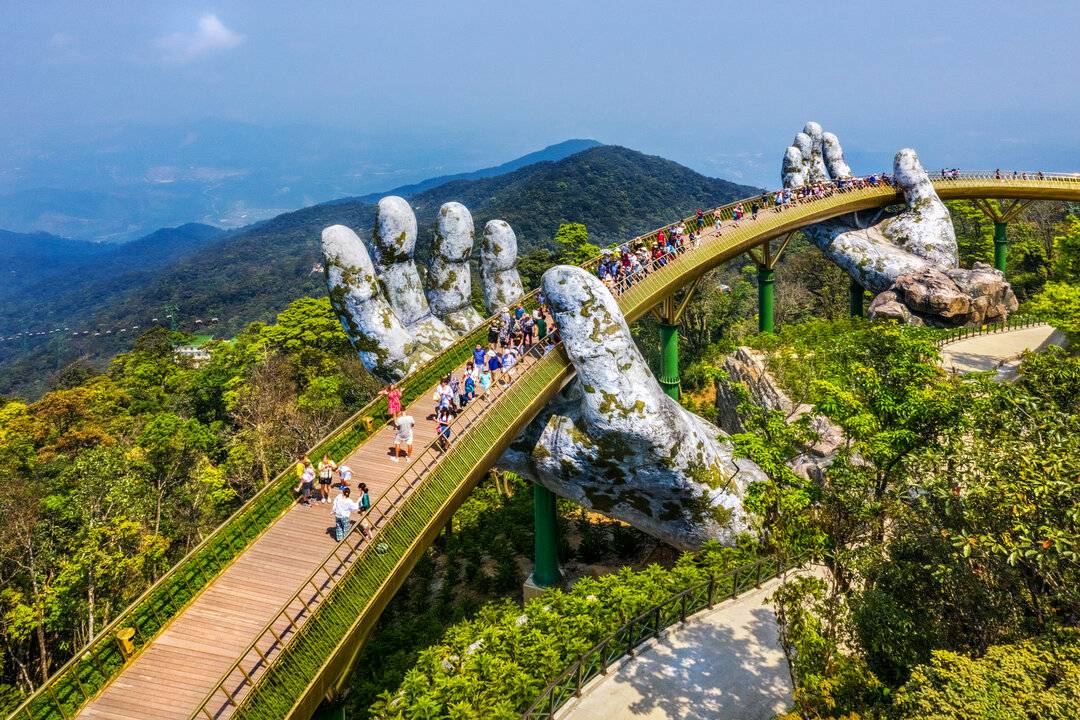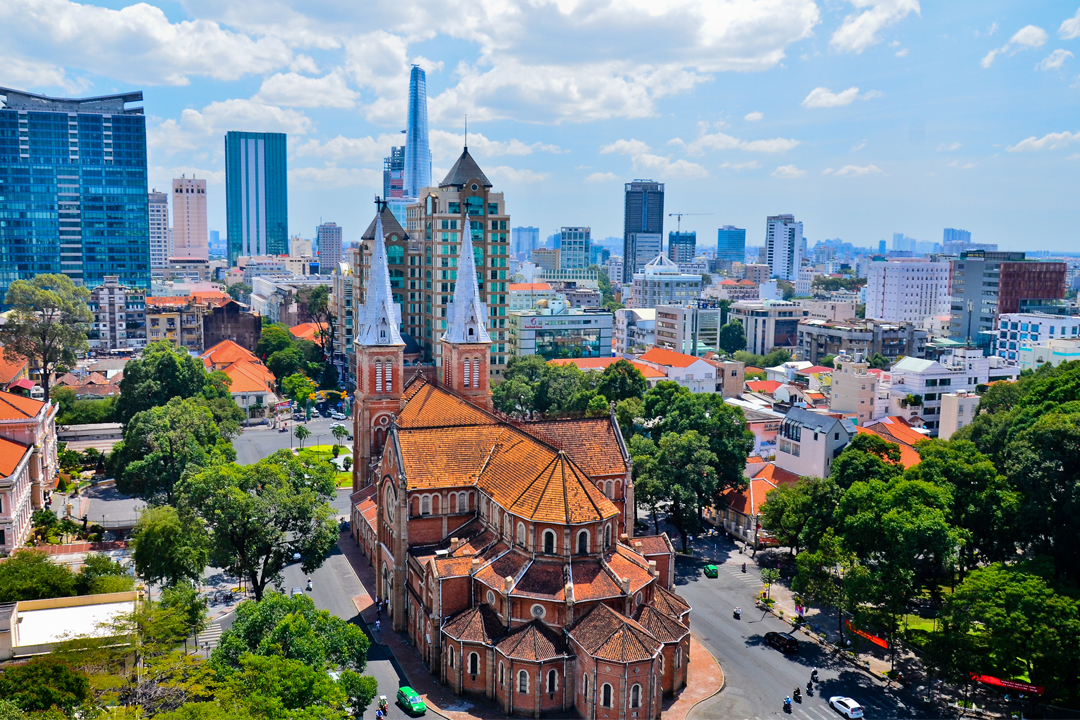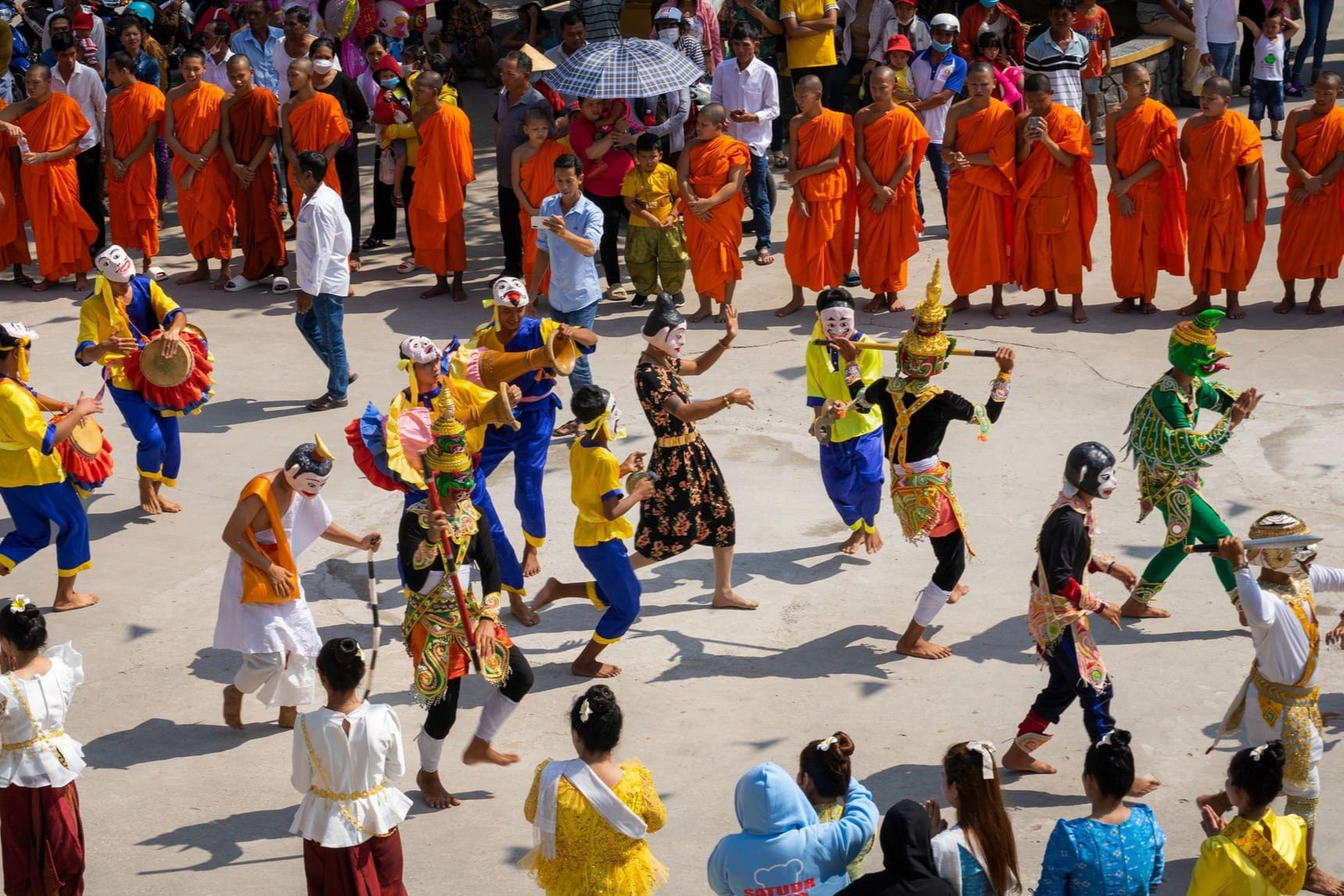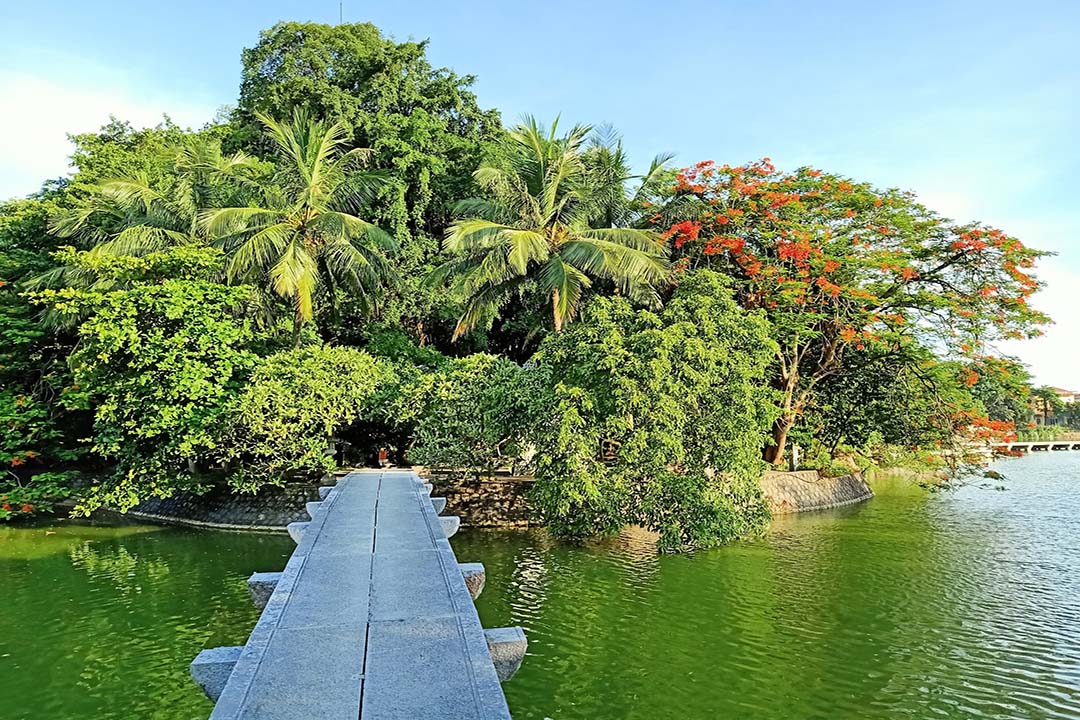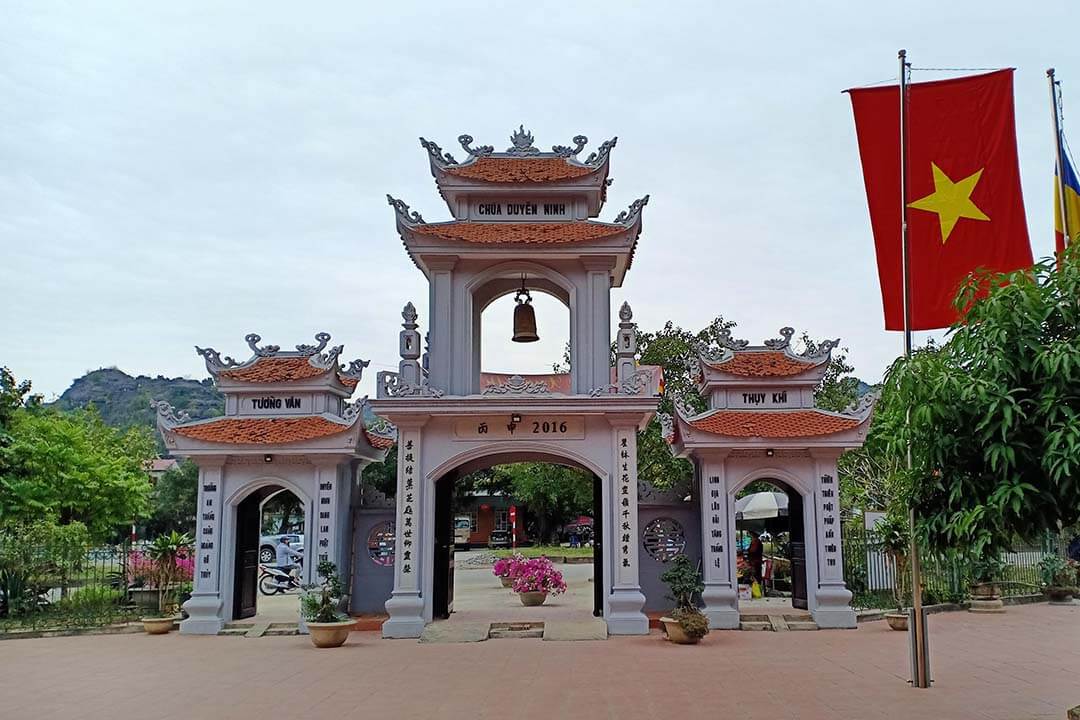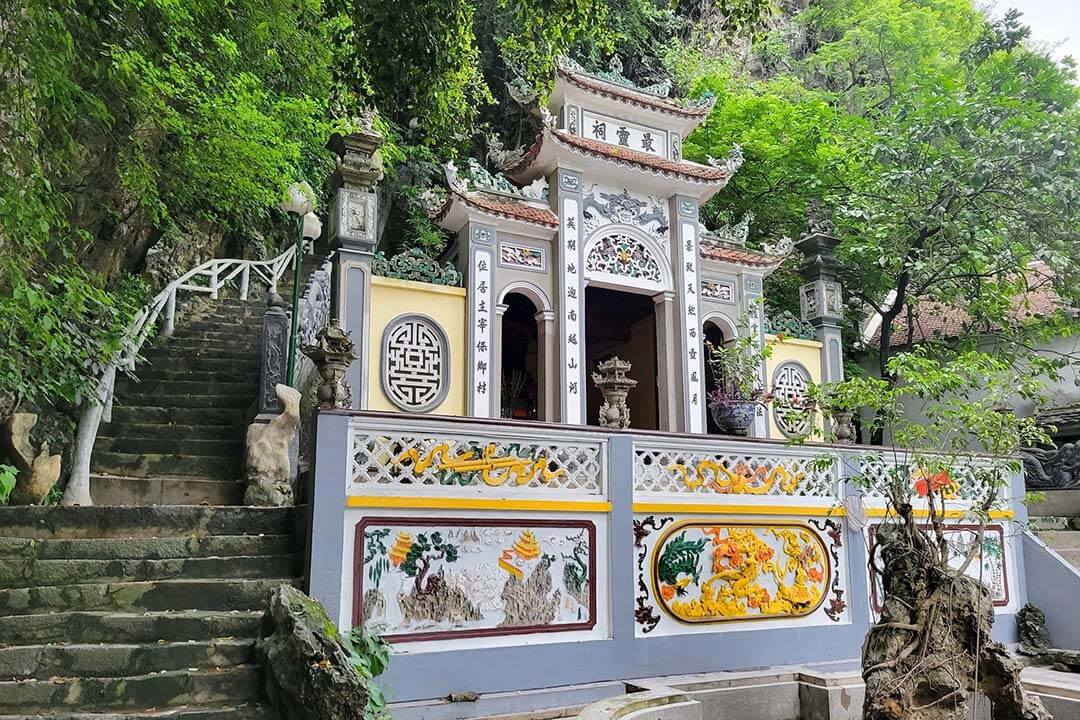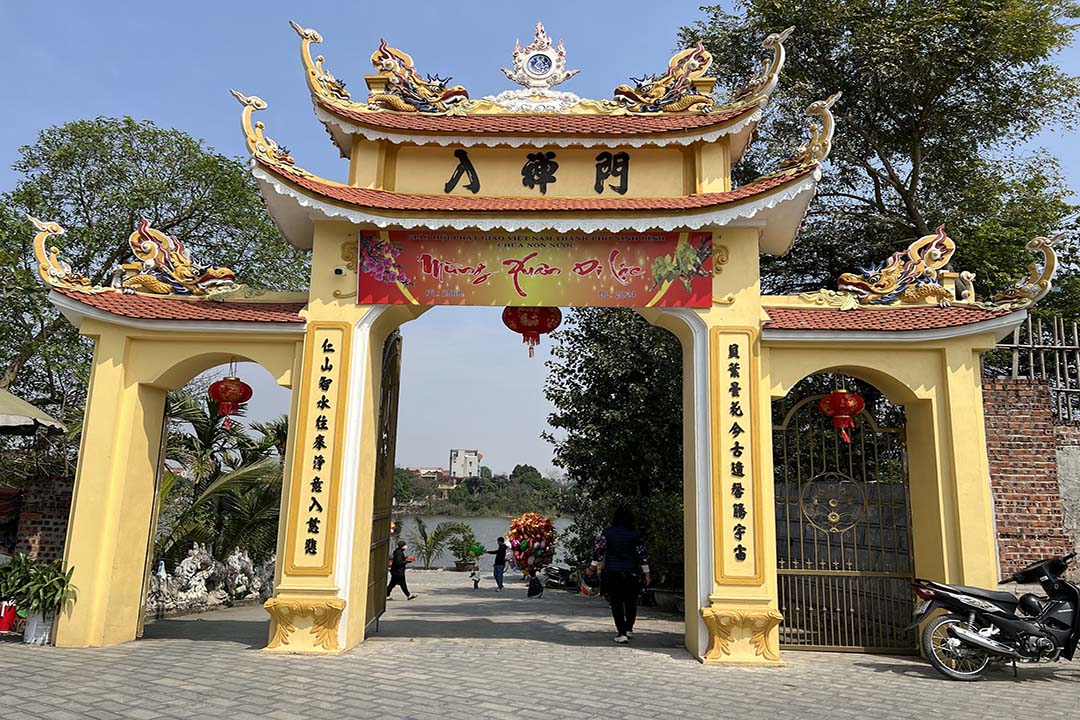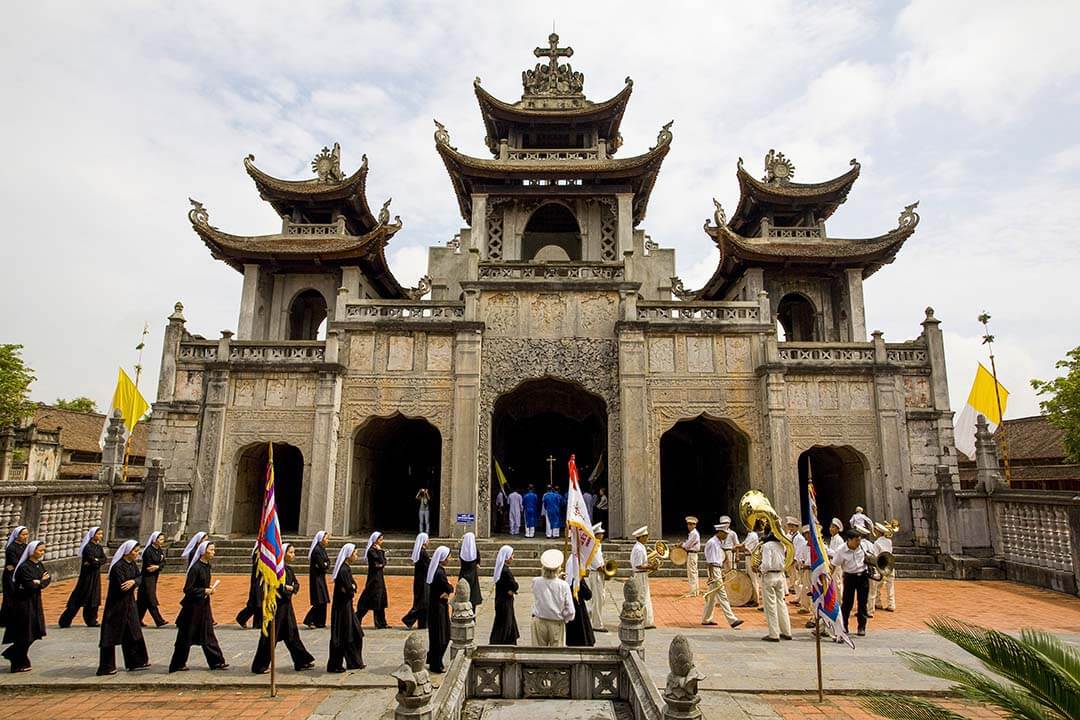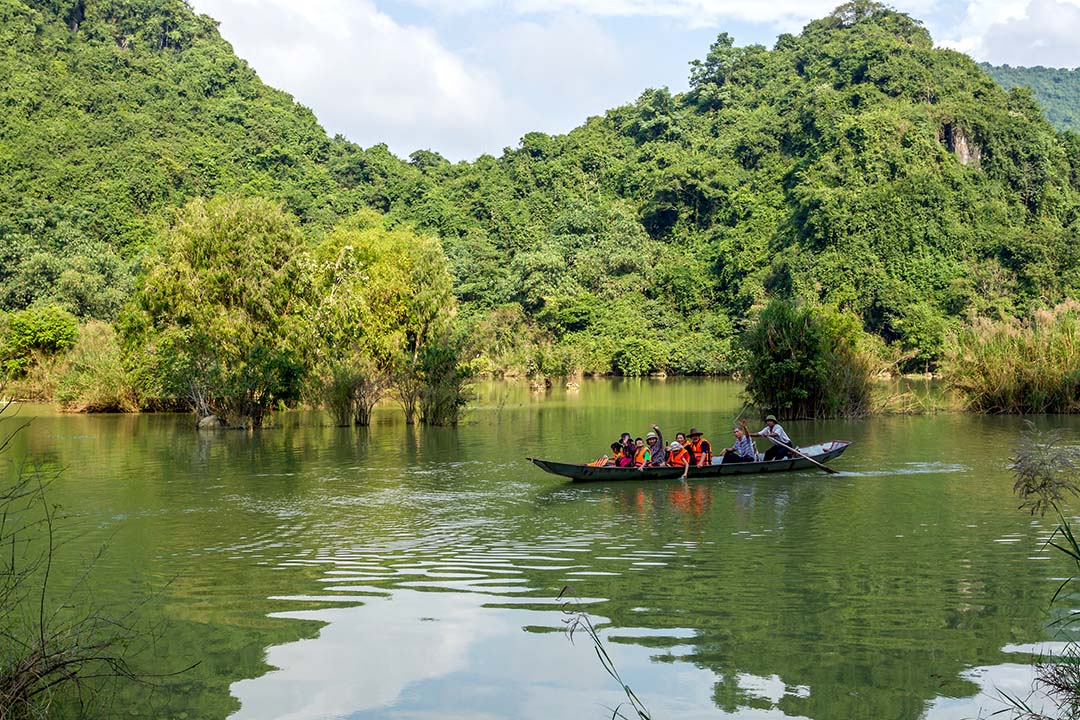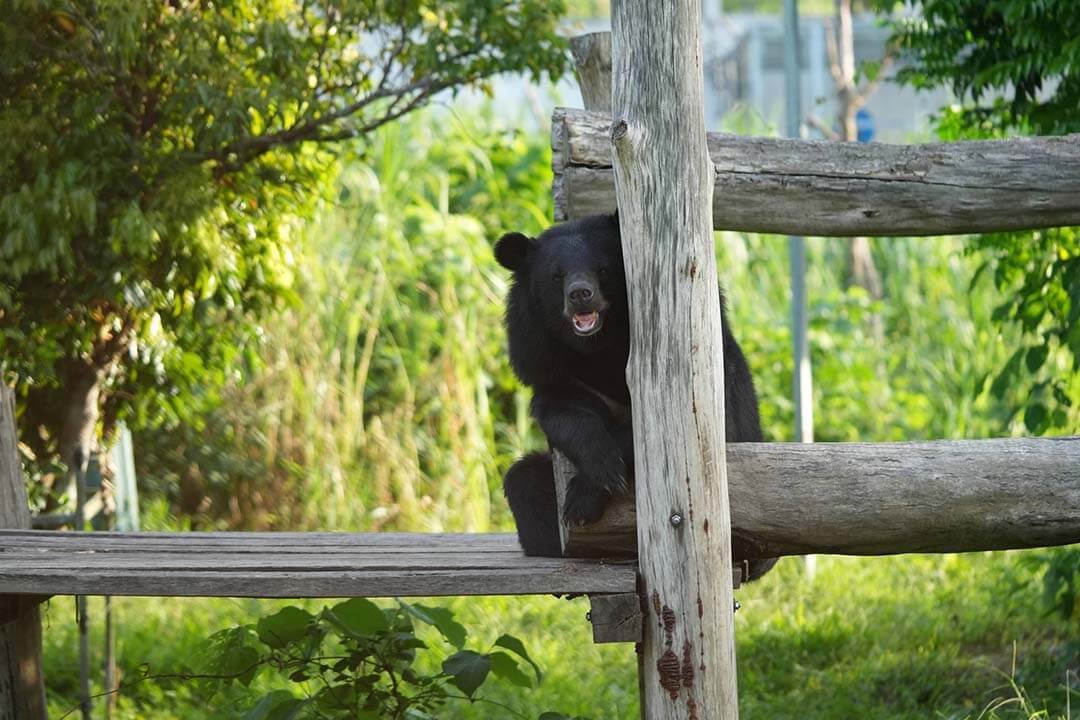Sep - 17 - 2025
Thung Nang, also known as Sunny Valley, is a captivating natural attraction located in Ninh Binh, Vietnam. Nestled in Dam Khe village, Nam Hoa Lu Ward, Ninh Binh Province ( former Ninh Hai Commune), this destination is just over 100 kilometers from Hanoi, making it easily accessible for a memorable getaway. Thung Nang boasts majestic mountains and clear rivers, creating a picturesque landscape that feels both intimate and poetic.
The area has recently gained popularity in the tourism scene, allowing travelers to explore its untouched beauty and vibrant ecosystem. Its proximity to other notable sites, such as Tam Coc and Bich Dong Pagoda, makes it an ideal stop for those looking to discover Ninh Binh.
GTrip will provide insights on how to plan your visit, recent attractions, the various activities available, and helpful tips to enhance your experience in Sunny Valley. Whether you’re seeking adventure or a peaceful retreat, Sunny Valley offers a perfect blend of nature and culture that promises to leave you in awe.
The history and cultural context of Thung Nang
Thung Nang is a place steeped in history and cultural significance, deeply embedded in the broader narrative of Ninh Binh province.
Historical significance
The historical context of Thung Nang is closely tied to Ninh Binh’s rich heritage. This area has been a vital part of Vietnamese history, serving as a strategic location during the resistance against the Mongol invaders. Throughout the centuries, various dynasties, including the Dinh and Le dynasties, have recognized Ninh Binh as a center of political and cultural importance.
One key historical event that significantly influenced Sunny Valley was the construction of the Hoa Lu Citadel in the 10th century under the Dinh and Early Le Dynasty. This citadel became the capital of Vietnam, marking a pivotal point in the nation’s history. As the surrounding landscapes were developed, they played a crucial role in supporting the livelihoods of local communities through agriculture and fishing.
According to local lore, the name “Thung Nang” originates from the local dialect, where “Thung” refers to flooded lowlands surrounded by rocky mountains. During summer, the sunlight casts a golden hue on the limestone formations, creating a mesmerizing scene. This led locals to adopt the name Thung Nang, or Sunny Valley.
>> You can explore more about Hoa Lu Citadel at Hoa Lu Ancient Capital of Ninh Binh

Lotus ponds inside Thung Nang and historical values create the characteristics of this place
Cultural importance
Thung Nang plays a subtle yet significant role in local festivals that celebrate Vietnam’s spiritual and agricultural heritage. During the Trang An Festival in April, participants from Thung Nang join neighboring communities in water processions. They wear traditional costumes and make offerings at temples to honor ancestors. This celebration is also a time for praying for prosperity.
The Hoa Lu Festival in March, honoring Emperor Dinh Tien Hoang, is another key event where locals engage in folk games, martial arts, and boat races. Thung Nang’s peaceful landscape serves as a place for quiet reflection, linking the area’s natural beauty with cultural reverence.
Spanning 8 hectares, the valley includes two main areas: Thung Nang Ngoai (Outer Sunny Valley) and Thung Nang Trong (Inner Sunny Valley). Each offers unique landscapes and ecological diversity. The blend of cultural practices and historical narratives enriches the local culture, offering a unique experience for those exploring this enchanting region.
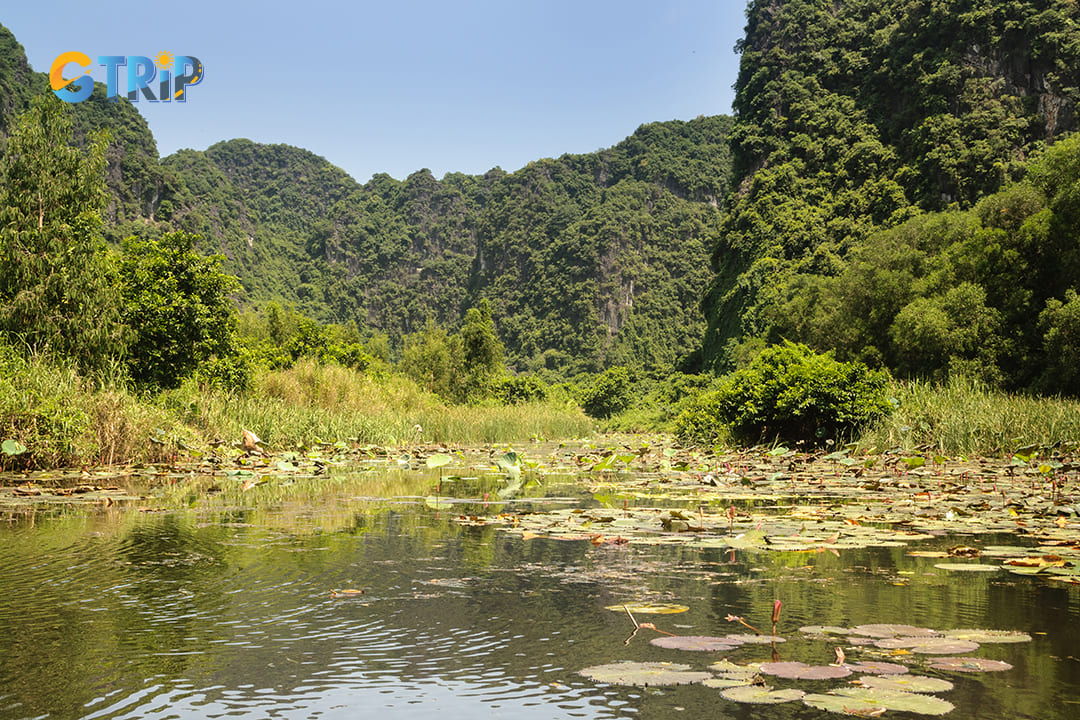
The sun shines into the Valley, creating a bright yellow scene, and it is the origin of the word "Nang" in "Thung Nang"
Natural features and environment of Thung Nang
It is made of many beautiful natural features that can draw your attention at the very first time.
The scenic landscape
The landscape encompasses towering limestone karsts, winding waterways, and vibrant rice paddies. They all create a picturesque backdrop that is both serene and mesmerizing.
Limestone karsts and rock formations
At the heart of the valley’s allure are its impressive limestone karsts, which rise dramatically from the valley floor. These majestic rock formations are a hallmark of Ninh Binh’s topography, characterized by their rugged cliffs and unique shapes. The karsts are often adorned with lush greenery, enhancing their beauty and creating a striking contrast against the deep blue sky.
As sunlight filters through the clouds, it casts enchanting shadows on the karsts, further enhancing their visual appeal. The interplay of light and nature provides opportunities for stunning photography, making it a haven for photographers and nature enthusiasts alike.
Waterways and rice paddies
The scenic landscape of Thung Nang is further enriched by its tranquil waterways, which meander gracefully through the valley. These rivers not only add to the valley’s aesthetic charm but also serve as vital resources for local agriculture. Surrounded by verdant rice paddies, the waterways reflect the vivid greens and golds of the surrounding fields.
During the harvest season, the rice paddies transform into a shimmering sea of golden grains, making it an idyllic spot for travelers. The gentle sounds of flowing water combined with the rustling of rice stalks provide a soothing soundtrack. They enhance the overall sense of serenity in the valley.
Aesthetic comparison with other valleys
While Thung Nang is undoubtedly a gem in its own right, it can be compared to other popular valleys in Ninh Binh, such as Tam Coc and Trang An. Each valley offers a distinct visual experience, yet it stands out due to its unique combination of limestone karsts, waterways, and rice fields.
Tam Coc, often referred to as “Ha Long Bay on land”, features similar limestone formations but is renowned for its boat tours through caves and around the karsts. In contrast, Sunny Valley offers a more tranquil experience, allowing you to immerse yourself in the natural beauty without the hustle and bustle.
Trang An showcases a different aspect of Ninh Binh’s landscapes with its winding waterways and lush green hills. However, Sunny Valley’s charm lies in its serene beauty and the harmonious blend of land and water, providing a picturesque setting.
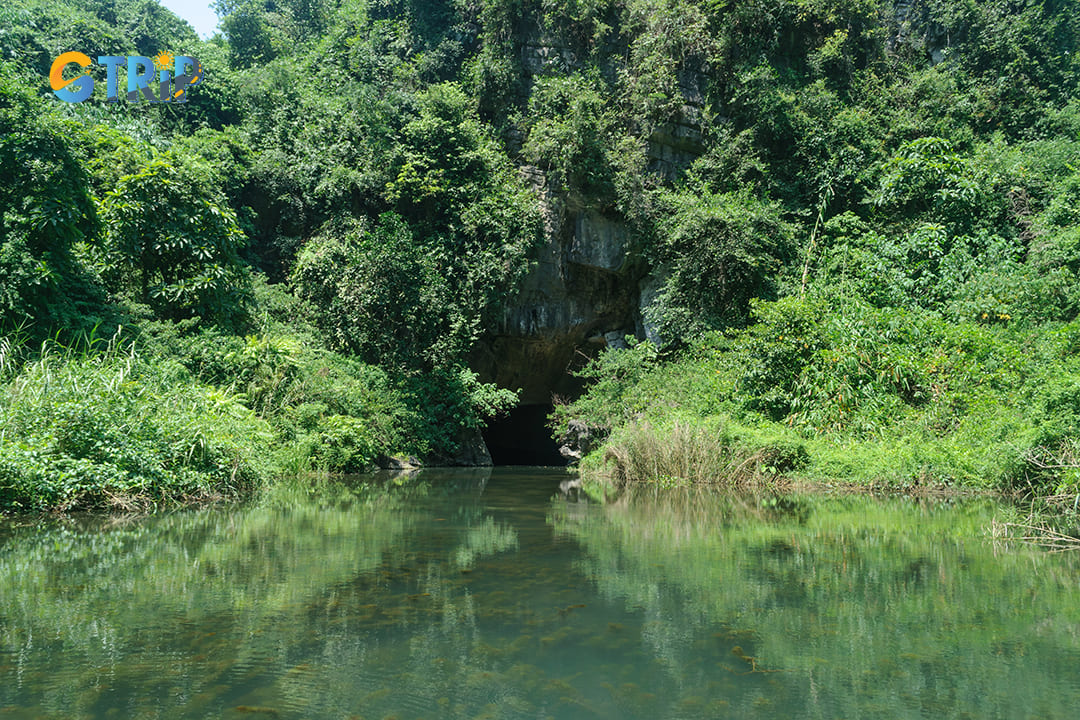
The valley inside Thung Nang and is also the origin of the word "Thung" in "Thung Nang"
The flora and fauna of Thung Nang
It is not only celebrated for its breathtaking landscapes but also for its rich biodiversity. The flora and fauna of this stunning valley contribute to its ecological balance and add to the area’s natural charm.
Flora of Thung Nang
The flora consists of a diverse range of plant species that flourish in its various habitats. This variety plays a crucial role in supporting the local ecosystem and enhancing the valley’s beauty.
- Bamboo groves
Bamboo groves are a striking feature, characterized by their tall, slender stalks that can reach heights of 10 to 20 meters. These groves thrive in the valley’s warm, humid climate, creating a vibrant green canopy that offers shade and habitat for various wildlife. Bamboo plays a vital ecological role by preventing soil erosion and providing shelter for birds and small mammals.
- Rice fields
The rice fields are essential to the region’s agricultural heritage. These fields transform dramatically with the seasons, from lush green in spring to golden in autumn when the rice is ready for harvest. Local farmers employ traditional, sustainable farming practices, relying on nearby waterways for irrigation.
- Aquatic plants
The waterways are home to beautiful aquatic plants, including water lilies and lotus flowers. Water lilies float gracefully on the surface, while lotus flowers bloom in vibrant pinks and whites, symbolizing purity and tranquility. These plants are crucial for the ecosystem, providing oxygen and habitats for aquatic life while filtering water.
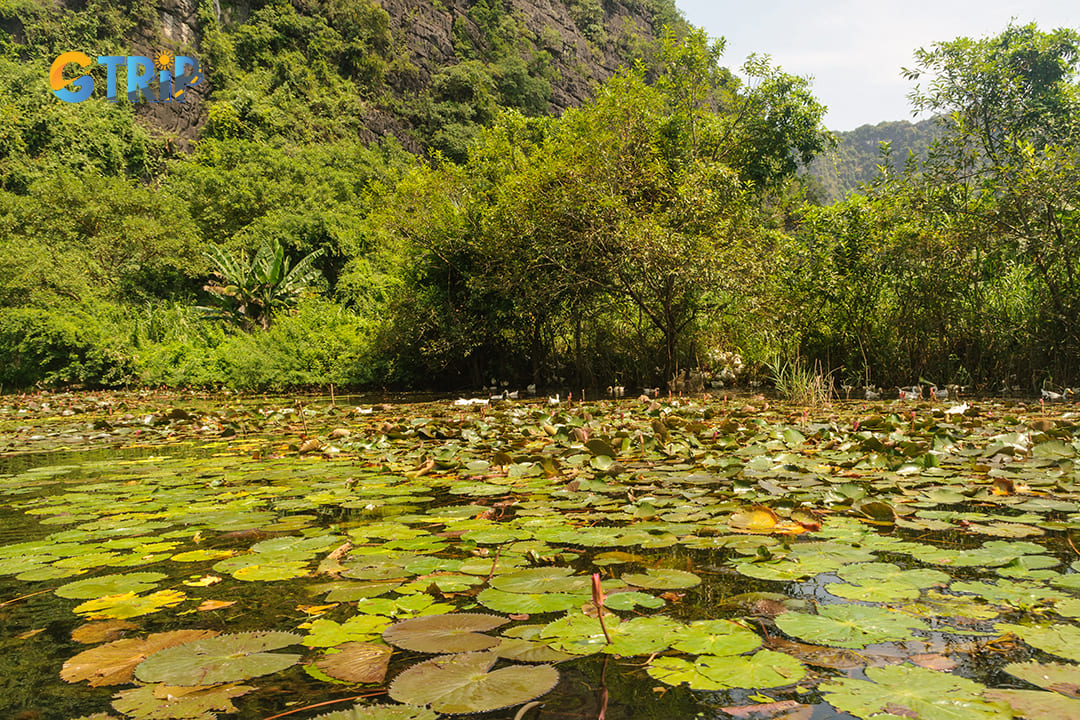
Many diverse types of plants grow well in Thung Nang creating a rich flora
Fauna of Thung Nang
The wildlife is equally impressive, with a variety of animal species that coexist harmoniously within the valley’s diverse ecosystems.
- Bird species
It is a haven for birdwatchers, as it hosts numerous bird species. Commonly seen birds include herons, kingfishers, and various migratory birds that pass through the region. These birds often inhabit the rice fields and wetlands, where they can find ample food sources. Birdwatchers are often delighted by the sight of herons gracefully wading through the rice fields and the vibrant flashes of kingfishers darting along the waterways.
- Fish
The waterways are rich in aquatic life, including several species of fish. Common fish found in the rivers include tilapia, catfish, and various small indigenous species. These fish not only contribute to the local diet but also play a vital role in the aquatic ecosystem.
These fish are integral to the livelihoods of the community, supporting both sustenance and traditional fishing practices. Their presence in the rivers underscores the health of the aquatic environment and contributes to the rich tapestry of life.
- Other wildlife
Beyond birds and fish, the valley is alive with diverse wildlife that enhances the valley’s ecological richness. Small mammals, such as rodents and civets, roam the forests and rice paddies, while snakes and lizards often bask in the sun, showcasing the area’s vibrant biodiversity.
The buzzing of insects, including colorful dragonflies and butterflies, fills the air, adding to the valley’s lively atmosphere. This variety of wildlife reflects the ecological balance within the valley. It is a captivating destination for nature lovers and outdoor enthusiasts alike.
Biodiversity and ecosystems
The biodiversity is a result of its varied ecosystems, which consist of mountainous terrain, riverine habitats, and agricultural landscapes. This combination creates an environment where different species can thrive, ensuring a balanced ecosystem.
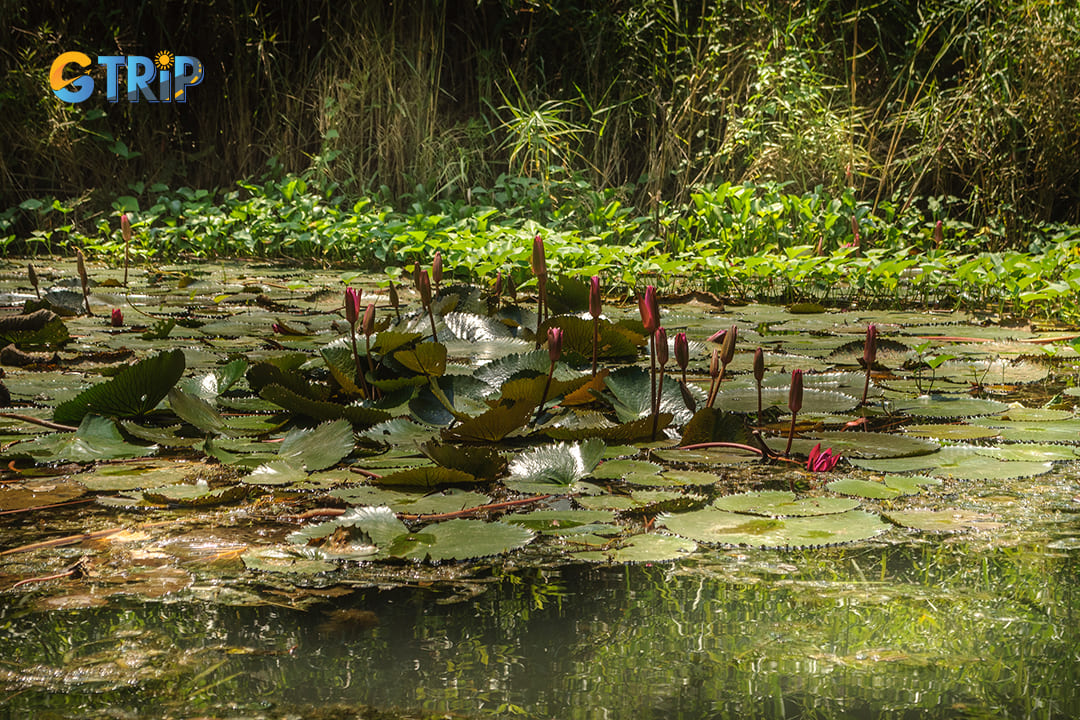
The lotus ponds and trees inside Thung Nang create a diverse ecosystem for this place
The climate and best time to visit Thung Nang
It experiences a temperate and humid climate that significantly influences its natural beauty and people’s experience. The weather varies throughout the year, dictating the best times for exploration and appreciation of this stunning valley.
Overview of Thung Nang’s climate
The climate is characterized by warm summers and mild winters. Temperatures typically range from 25°C to 31°C (77°F to 88°F) during the peak summer months.
From May to October, particularly during the wet season, rainfall is common. This period sees increased humidity and frequent showers, contributing to the lush greenery that envelops the valley. Conversely, the dry season from November to April offers cooler temperatures and clearer skies, making it an appealing time for outdoor activities.
Best time to visit Thung Nang
The best time generally falls between April and June and September to October.
- April to June: During these months, the valley is at its most captivating. The temperature is pleasant, ranging from 28°C to 31°C (82°F to 88°F). By May, the rice fields begin to turn golden, creating a stunning contrast against the green landscape. This season showcases the natural beauty, resembling a vibrant canvas that captivates the eye. The sunny days are ideal for outdoor exploration, photography, and boat rides along the waterways.
- September to October: This period also offers favorable weather conditions, with temperatures cooling slightly after the summer heat. The landscape remains lush from the rainy season, and the air is fresh and invigorating. The harvest season in October presents a unique opportunity to witness local farming activities and traditional practices. The rice fields are ripe for harvesting, creating a picturesque scene of farmers working against a backdrop of stunning natural beauty.
Visitor experience
Understanding the climate and best times to visit enhances the overall experience. During peak seasons, you can enjoy pleasant weather, vibrant landscapes, and local cultural activities. However, it’s important to plan ahead, as the popularity of these months can lead to increased tourist traffic. During the low season, you still can enjoy the beauty of the valley, but in the more tranquil atmosphere because of the peace.

The rice fields inside Thung Nang, and it will be more beautiful in the ripe rice seasons
Geographical and geological features
It is defined by its breathtaking geographical and geological features, characterized primarily by striking limestone karst formations. These natural wonders create a unique landscape that draws people from around the world.
Geological formations
The geological features of Sunny Valley are primarily composed of limestone, shaped over millions of years through a process of erosion and tectonic activity. The karsts, with their steep, jagged peaks and rugged cliffs, form a dramatic backdrop against the lush greenery of the valley.
- Limestone formations: The limestone karsts are rich in calcium carbonate and display intricate patterns created by natural forces. These formations have weathered over time, resulting in sharp ridges, deep valleys, and steep cliffs.
- Cave systems: The area is home to a network of caves that have formed within the limestone rock. These caves are characterized by stunning stalactites and stalagmites, showcasing nature’s artistry. The geological activity that created these caves has led to various formations, some of which are large enough to explore.
Exploration history and nearby caves
The valley boasts several caves that are accessible by boat, adding to the adventure of exploring this remarkable landscape.
- Thung Nang Cave: One of the notable caves in the area, Thung Nang Cave features impressive rock formations and a rich history of exploration. Accessible via traditional sampan boats, you can glide through serene waterways while taking in the breathtaking scenery. The cave’s interior reveals fascinating geological formations, creating a mystical atmosphere that captivates all who enter.
- Cave exploration: Many of the nearby caves have historical significance, with records of local communities using them for spiritual or ceremonial purposes for centuries. The exploration of these caves has attracted both locals and tourists, making boat rides through the waterways a popular activity. As you navigate through the caves, you will encounter impressive natural rock formations. Some of these feature ancient inscriptions and unique shapes, each telling part of the region’s geological story.
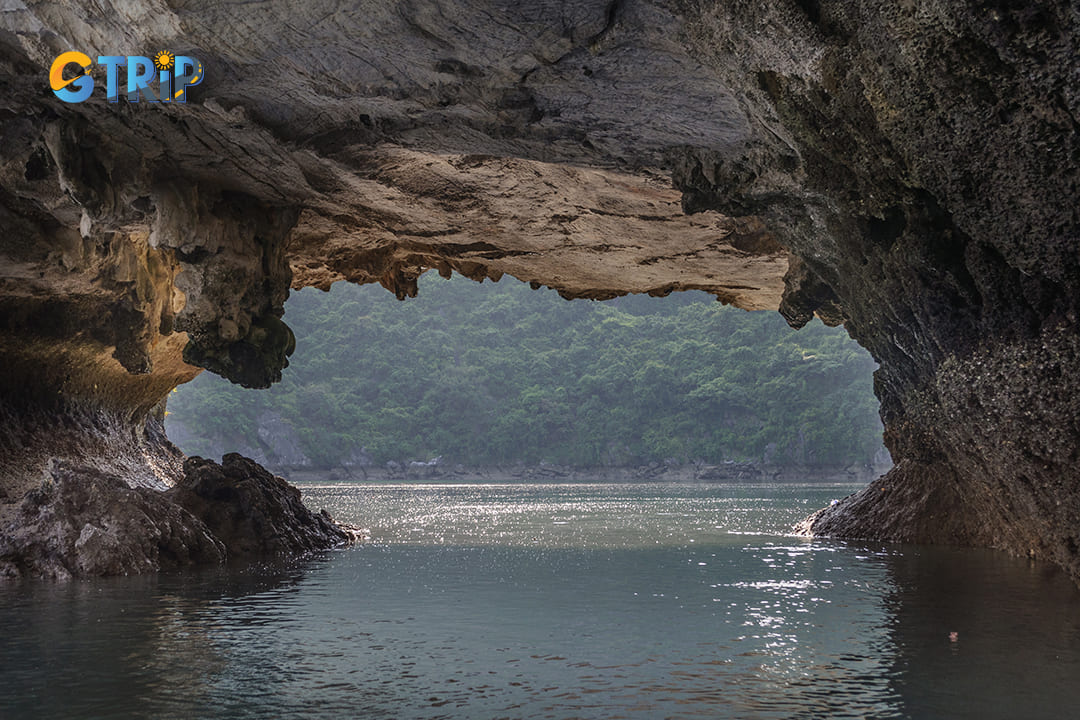
Huge Caves are always interesting things for us to admire
3 things to do in Thung Nang
There are several captivating attractions, such as Ba Doi Mountain, Coc Mountain, Mang Mountain, and Vang Mountain. Thung Nang Temple is dedicated to Lord Thuong Ngan, while the ancient Voi Dai Temple honors Tran Trach Son Lam. Each of these valleys is interconnected by a network of caves that wind through the mountains.
As you take a boat through these caves, they are treated to breathtaking views of the enchanting scenery that unfolds before them. On days when a gentle breeze blows, the sweet sound of reed flutes can be heard wafting from the shore. It offers numerous experiences and adventures to fully enjoy the beauty and serenity of this stunning region.
Cruise on a boat tour for scenic photography
The Thung Nang boat tour is a captivating journey. It allows you to explore the scenic beauty of the area while enjoying a tranquil experience on the water. Here’s a closer look at what to expect during this memorable cruise.
Departure point and initial setting
The boat tour typically begins at a designated dock near the entrance of the valley. Here, traditional wooden boats, often rowed by skilled local fishermen or guides, await eager travelers. Each boat is designed to accommodate small groups, ensuring an intimate and personalized experience.
As you settle into the boat, you’ll be surrounded by the lush landscape that characterizes the valley. The soothing sound of water gently splashing against the hull sets the stage for an unforgettable adventure.
Journey through serene waters
As the boat sets off, you will glide smoothly along the winding rivers that meander through the valley. The tour takes you past stunning limestone karsts, which rise majestically from the water. Each turn of the river reveals a new vista, showcasing the dramatic rock formations that define the region’s geography.
The boats often navigate through narrow channels flanked by thick vegetation, providing a sense of exploration. As you cruise, the local guides may share interesting facts about the geological history of the area, enriching your understanding of the landscape.

Cruise on a boat tour in Thung Nang for scenic photography
Exploration of caves
One of the highlights of the boat tour is the exploration of nearby caves, such as Thung Nang Cave. As you enter the caves, you will be captivated by stunning rock formations. Stalactites hang from above, while stalagmites rise from below. Each has taken thousands of years to form. The guides illuminate these formations, enhancing your photography opportunities as you capture the mystical beauty of the cave interiors. The boat allows for close-up views of these geological wonders, and the still waters reflect the cave’s features beautifully.
Scenic photography opportunities
Throughout the journey, the Thung Nang boat tour offers countless opportunities for scenic photography. The play of light across the limestone cliffs, especially during early morning or late afternoon, creates dynamic shadows and highlights that enhance your images.
- Golden rice fields: As you approach certain areas, the vibrant green and golden rice paddies come into view, contrasting beautifully with the dark limestone. The reflections of these fields in the water add depth to your photographs, making for striking compositions.
- Wildlife encounters: Keep your camera ready for unexpected wildlife encounters. Herons, kingfishers, and other birds are often spotted along the banks, providing unique opportunities for nature photography. The serene environment allows for quiet observation, ensuring that you capture the essence of these moments.

Opportunity to take landscape photos in Thung Nang while exploring this place by boat tour
Explore limestone caves inside Thung Nang
Exploring the limestone caves is an exciting adventure that invites you to discover stunning natural formations.
Navigating the caves
The journey begins with a boat ride through serene waters, leading to the cave entrances. As you navigate narrow channels surrounded by towering limestone cliffs, anticipation builds. Once at the cave, you’ll disembark and enter a cool, mystical atmosphere with guides equipped with flashlights.
Discovering geological wonders
Inside, you will encounter magnificent stalactites and stalagmites, adorned with delicate mineral deposits. Each cavern offers unique patterns and textures, showcasing the beauty of the limestone. Guides share fascinating insights about how these formations were created through water erosion over millennia.
Stalactites and caverns
The stalactites hang like icicles from the ceiling, while expansive caverns feature high ceilings that enhance acoustics. Some people enjoy testing echoes, while others capture stunning photographs of the natural scenery.
Adventure and exploration
The thrill of discovery continues as you navigate winding passages, potentially uncovering hidden alcoves and secret chambers. For the adventurous, guided trekking or climbing opportunities may be available, offering a deeper exploration of the cave systems.
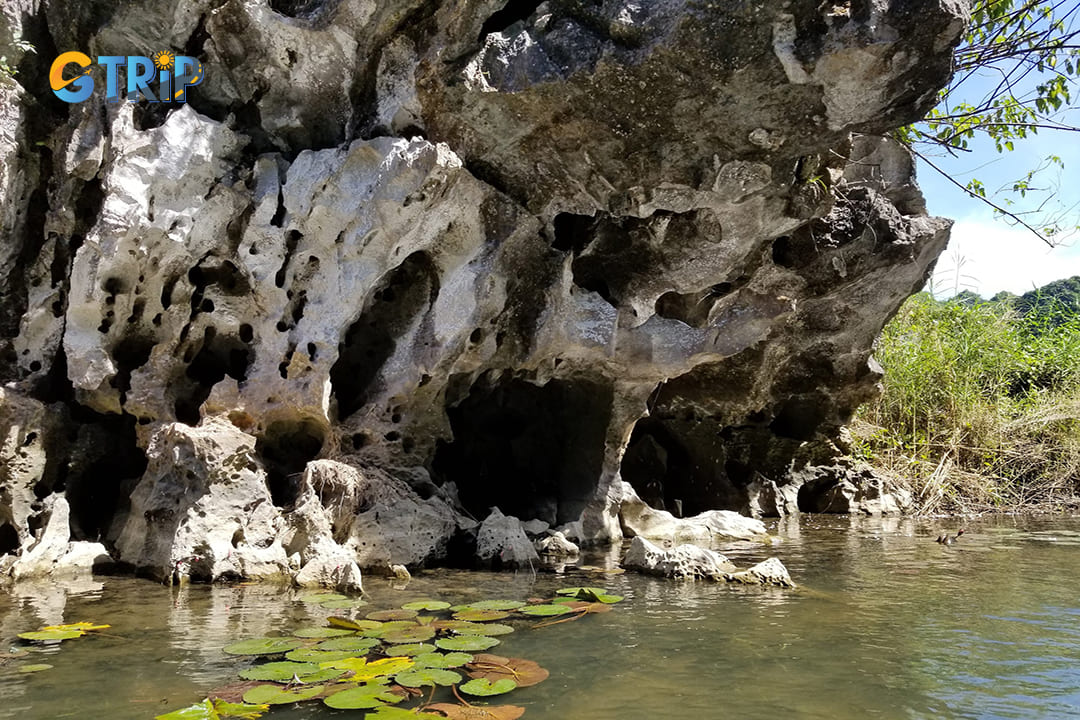
Adventure and exploration the caves
Visit and explore ancient temples and pagodas
Visiting and exploring the ancient temples and pagodas offers a unique opportunity to admire the region’s rich cultural heritage and spiritual significance. Each site reflects the history and architectural beauty of the area, inviting travelers to discover the deep-rooted traditions of this picturesque destination.
One of the key highlights is Thung Nang Temple, dedicated to Lord Thuong Ngan, also known as the God of Mountains or Mountain Deity. She is a significant figure in Vietnamese mythology and folk religion. She is revered as the protector of nature, especially mountains and forests. The temple dedication originated from Mother worship. This serene temple is designed and built within a tranquil environment, surrounded by lush forests and flowing rivers. The natural landscape creates a majestic atmosphere, enhancing the spiritual experience. As you wander through the temple grounds, you can admire the intricate architecture and decorative motifs that adorn the buildings.
Another must-visit is Voi Temple, located just a short drive from Sunny Valley. This ancient structure is renowned for its meticulously carved stonework, showcasing the craftsmanship of the artisans from the Le Dynasty. Dedicated to Mr. Ly Dong Hai, the temple honors this historical figure known as the mountain and forest governor. The intricate designs and thoughtful layout of Voi Temple reflect its historical significance and the reverence held for the deity it honors.
You can take time to admire the architectural details, from carved stone pillars to beautifully painted altars. You can also learn about the various rituals and ceremonies that take place at these religious sites. The tranquil environment encourages a deeper connection to the spiritual aspects of the region.
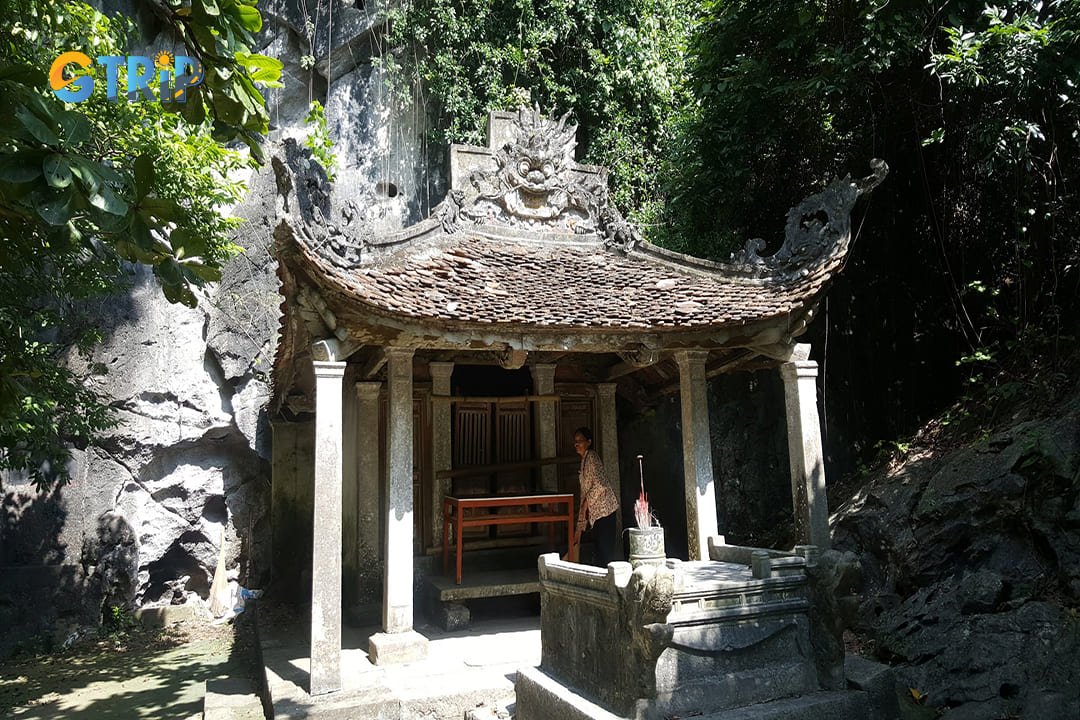
The wild but equally ancient temple inside Thung Nang
Boat tours at Thung Nang: Routes and pricing
Thung Nang boat tours offer a captivating way to navigate the serene waterways of this scenic area. These tours provide an immersive experience in nature, showcasing the region’s breathtaking landscapes and rich biodiversity.
Typical routes and itinerary
Starting point
The boat tour begins at the boat station. Here, you can board traditional wooden boats for a relaxing journey along a peaceful canal. The route is lined with lush greenery, including trees and bushes that create a natural, less commercialized atmosphere.
Cave exploration
As the tour progresses, you will navigate through two small but beautiful caves. These caves are known for their clear water and minimal light, creating a serene and mystical environment. The unique lighting enhances the natural beauty of the stalactites and formations, making for excellent photography opportunities.
Diverse landscape
The route showcases a diverse landscape, offering views of rice paddies, limestone karsts, and tranquil pools. During the journey, keep an eye out for various bird species and local wildlife, such as water buffaloes grazing in the fields. This natural setting allows for a deeper connection with the environment.
Tour duration
The boat tour typically lasts between 1 hour and 15 minutes to 2 hours. This duration provides a peaceful experience, especially when compared to busier locations like Tam Coc or Trang An. It’s an ideal way to soak in the natural beauty without the crowds.
Pricing information
- Cost of the boat tour: The price for the boat tour is 60,000 VND (approximately $3) per person.
- Entrance fee: An additional entrance fee applies: 15,000 VND (about $1) for adults and 5,000 VND (around $0.3) for children.
Booking and end of the tour
You can easily book their boat tours at the boat station upon arrival. It is advisable to arrive early, especially during peak travel seasons, to secure a spot.
At the end of the tour, guests will find themselves in a tranquil area where rowers may offer small souvenirs or local snacks for purchase. This allows for a perfect ending to the tour, giving you the chance to take home a piece of Sunny Valley’s charm.
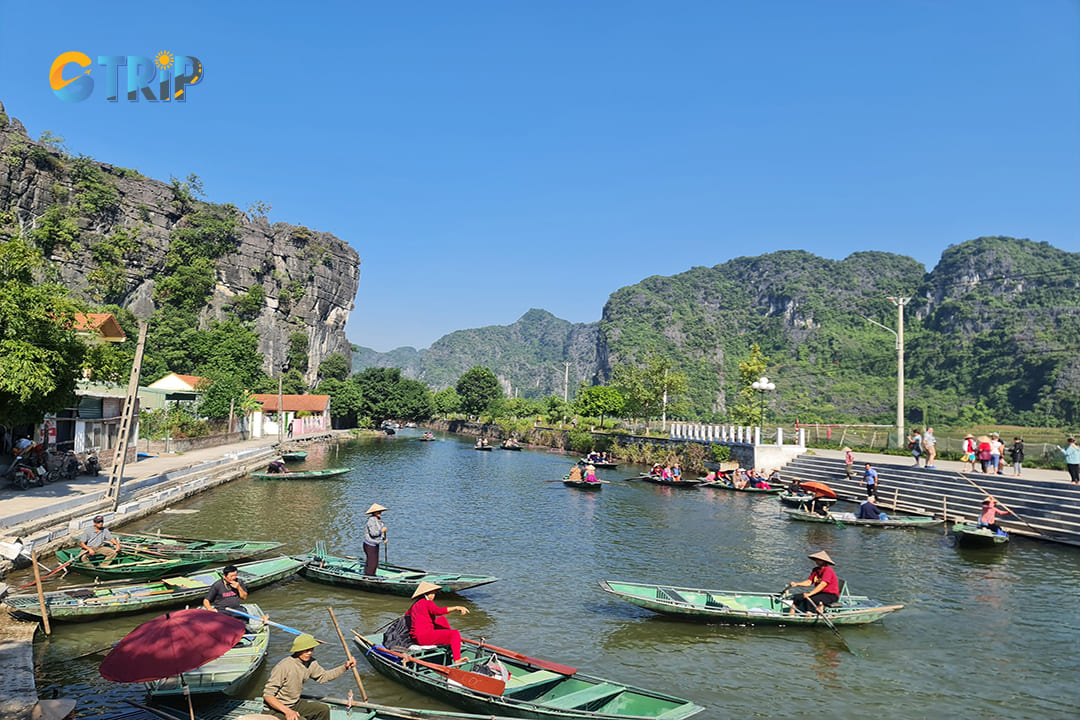
Dozens of tourists are excited to join boat tours when traveling to Thung Nang
How to get to Thung Nang
Reaching Thung Nang is relatively straightforward, thanks to its accessibility from nearby cities and attractions. This travel guide outlines various transportation options, directions, and important travel details for a seamless journey.
Directions for Travelers
From Ninh Binh City
Sunny Valley is approximately 12 kilometers from Ninh Binh city center. The journey typically takes around 25 to 30 minutes by motorbike or taxi, depending on traffic. To reach it from Ninh Binh, follow these directions:
- Head southeast on Tran Hung Dao Street.
- Turn onto Highway 1A, following signs for Hoa Lu.
- Continue until you see signs directing you to Sunny Valley. The roads are well-marked, making navigation easy.
From Hanoi
Sunny Valley is about 100 kilometers from Hanoi. The trip usually takes around 2 to 3 hours by car, depending on traffic conditions.
For those traveling from Hanoi:
- Take National Route 1A towards Ninh Binh.
- Follow signs to Ninh Binh and exit at Hoa Lu.
- From Hoa Lu, follow the same route as mentioned for Ninh Binh.
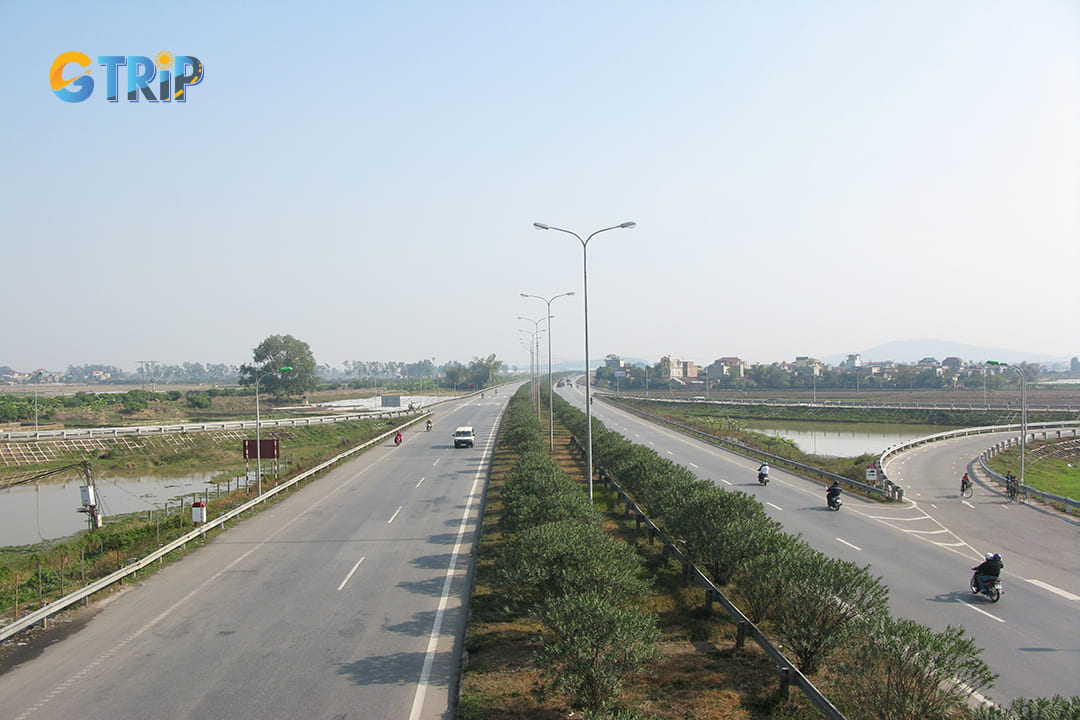
National route 1A to get to Thung Nang
Transportation options
- Bus
Buses are a budget-friendly option. Several bus companies operate routes between Hanoi and Ninh Binh. From Ninh Binh, local buses or taxis can take you directly to Thung Nang. - Taxi
Taxis provide a convenient and comfortable way to travel, especially for groups or families. Rides from Ninh Binh city center to Sunny Valley typically cost between 150,000 and 250,000 VND (approximately $6 to $10). - Motorbike
Renting a motorbike is a popular choice for adventurous travelers. This option allows for flexibility and the freedom to explore the surrounding areas. Rental shops are readily available in Ninh Binh, and the journey is scenic. - Bicycle
For those looking to enjoy a leisurely ride, bicycles can be rented in Ninh Binh. Cycling offers an up-close experience with the beautiful landscape, although it may take longer than other modes of transport.
Distance and travel time
| From | Distance | Estimated travel time | ||
| Taxi | Motorbike | Bus | ||
| Ninh Binh city center | Approximately 12 kilometers | 25 to 30 minutes | 25 to 30 minutes | 30 to 40 minutes (depending on stops) |
| Tam Coc | About 8 kilometers | 15 to 20 minutes | 15 to 20 minutes | 30 to 40 minutes |
| Trang An | Approximately 6 kilometers | 10 to 15 minutes | 10 to 15 minutes | 20 to 30 minutes |
Road conditions and accessibility
The road infrastructure leading to Sunny Valley is generally well-maintained, with good-quality pavement suitable for various types of vehicles. However, there are a few points to consider:
- Narrow roads: Some routes, particularly near the entrance to Sunny Valley, may be narrow. Exercise caution while navigating these areas, especially if driving a larger vehicle.
- Parking availability: Parking spaces can be limited near the boat station, particularly during peak tourist seasons. It is advisable to arrive early or consider using a taxi to avoid parking issues.
- Accessibility: All mentioned modes of transport can access the valley easily, making it accessible for most travelers.
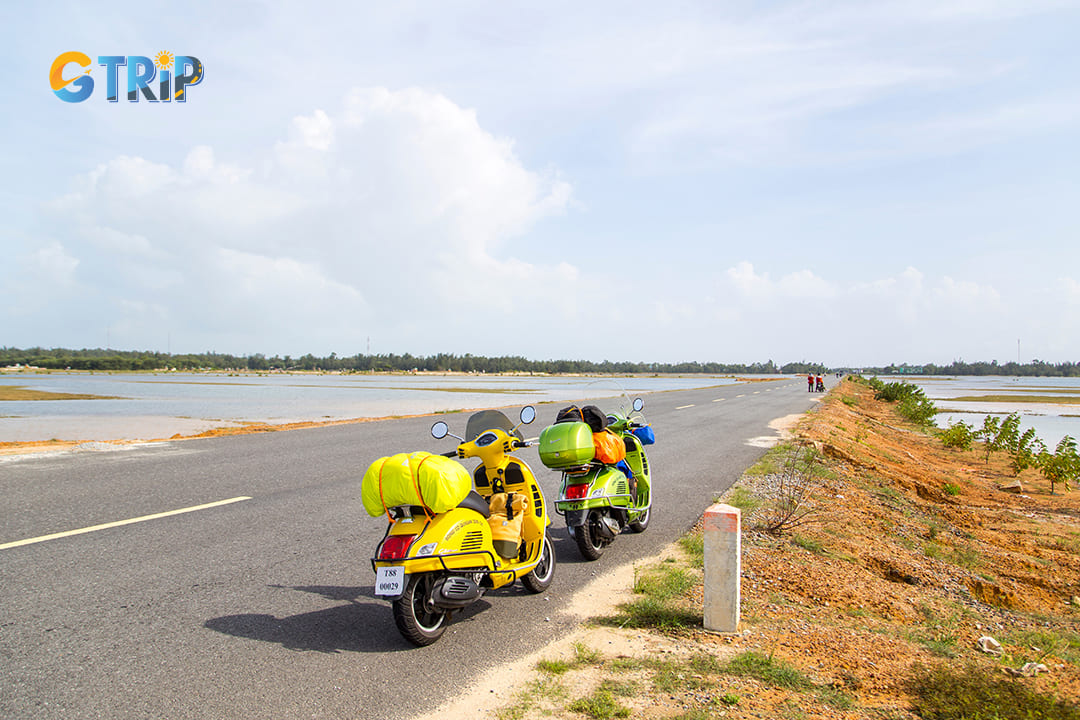
A motorbike trip to Thung Nang will help you relieve stress and enjoy the beautiful scenery on the way to Thung Nang.
Visitor experience and reviews
GTrip has organized tours for many foreign tourists to visit Thung Nang through the Ninh Binh tour package. Customers are actually very satisfied with this tourist destination and our services.
What to expect during your visit
At GTrip, we make it easy to explore Sunny Valley from start to finish. When you arrive, our staff will share the day’s plan, offer helpful recommendations, and make sure you’re comfortable. As you begin the journey, you’ll notice how much care goes into making every step seamless.
The boat tour is a favorite among tourists and offers a unique perspective of the valley’s landscape. Gliding along the peaceful river, you experience limestone karsts, open rice paddies, and tranquil waters. Our guides share local insights and stories, creating a memorable experience that stands out compared to other Ninh Binh destinations.
Visitor reviews and feedback
Our guests often rate their experience highly, with many sharing their opinions about the atmosphere, our friendly team, and the unspoiled beauty of the area. Here’s what travelers frequently say.
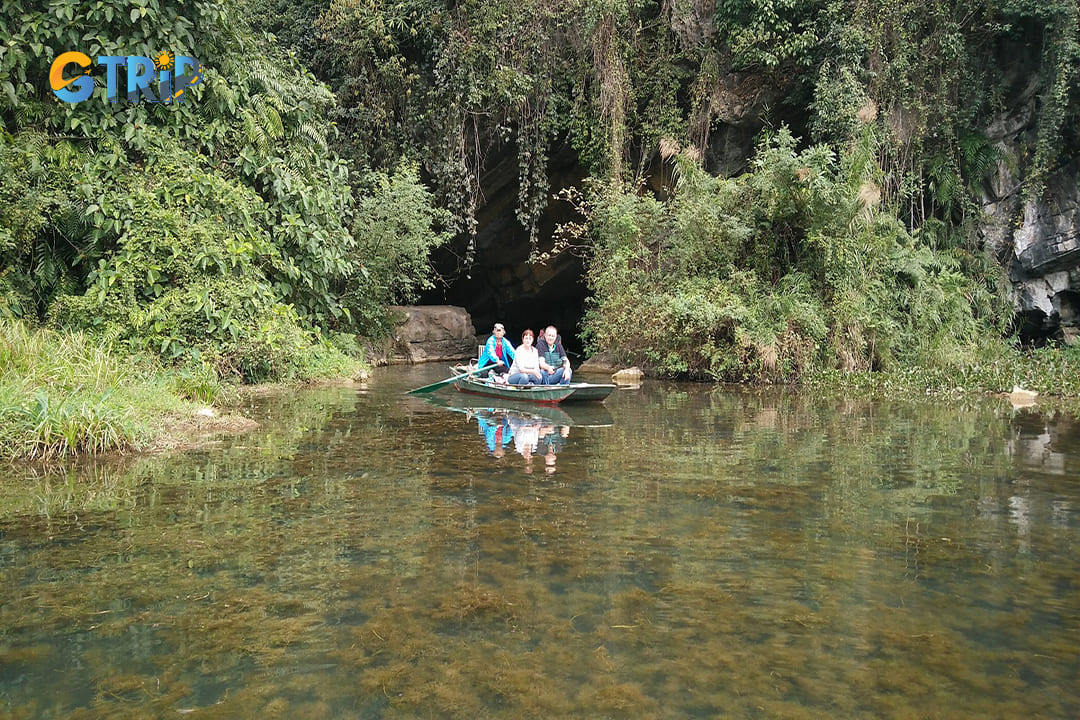
The winding rivers in Thung Nang with majestic views are ideal conditions for a boat tour
Travelers often review the valley as a picturesque and serene escape, appreciating the balance of natural features like limestone cliffs and lush fields. Compared to busier sites, Sunny Valley’s peacefulness is highly rated. Guests enjoy the quiet, uncrowded spaces that make the area feel personal and authentic. Many guests leave feedback praising GTrip’s knowledgeable, friendly guides who enhance the trip with stories and a welcoming attitude.
Some guests note that the access roads could use improvement, particularly for larger vehicles. A few reviews suggest adding more options like small cafes or shaded rest stops for comfort.
Seasonal visitor experience and recommendations
The landscape and atmosphere change beautifully with the seasons:
- Spring: Greenery thrives, and the weather is ideal for exploring.
- Harvest season (May to June): The rice fields turn a golden hue, providing stunning photo opportunities. Though busier during this season, the scenes make the trip worth it.
- Fall and winter: Cooler months are quieter, with fewer tourists. The misty mornings add to the valley’s peaceful allure.
During peak seasons, tours fill up quickly, so we recommend booking in advance to secure the best experience with GTrip.
Guests who share their reviews frequently recommend the Thung Nang boat tour, especially for those looking to escape the crowds and enjoy authentic, scenic beauty. With its timeless landscape and tranquil experience, a trip to Sunny Valley with GTrip promises a refreshing and unforgettable adventure.
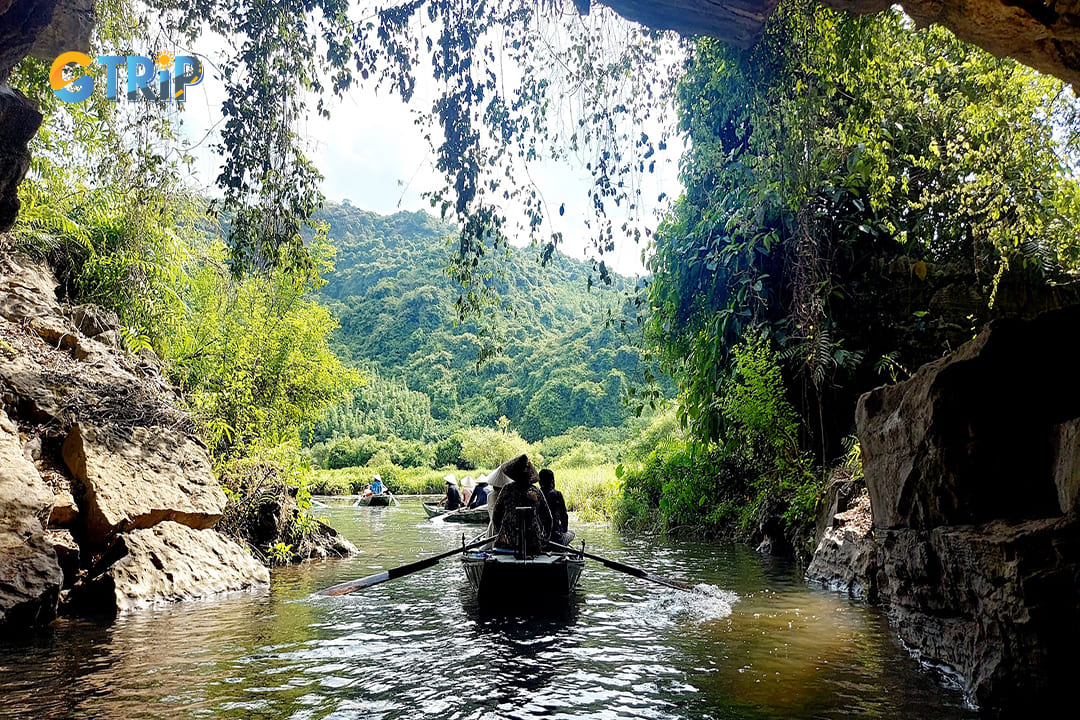
Experience a boat tour around Thung Nang
Travel tips when visit Thung Nang – Ninh Binh
Here are 7 tips for you when you visit Sunny Valley Ninh Binh.
- Best time to visit
We recommend visiting early in the morning or late in the afternoon to avoid midday heat and enjoy quieter moments. The dry season (October to April) provides clearer skies and calm waters for boat rides. The wet season offers a lush landscape but can raise water levels, which may affect boat trips.
- Bring cash
Boat tickets range from 130,000 – 200,000 VND per person, depending on the season. Bringing extra cash is advised for souvenirs or tips, as rowers often offer items for sale at the end of the tour.
- Wear comfortable clothing
Lightweight, breathable clothes and comfortable shoes are a must. We also advise bringing a hat, sunscreen, and sunglasses, especially in warmer weather, for a comfortable and enjoyable visit.
- Prepare for sun and rain
With a boat ride of 1.5 to 2 hours, a small umbrella or raincoat can be handy for unexpected rain. Sunscreen is also a must for protection against the sun’s rays.
- Enjoy the peace
The valley is much quieter and more natural than busier sites like Tam Coc or Trang An, so take advantage of the peaceful surroundings. Slow down and fully enjoy the area’s serene and untouched beauty.
- Keep your camera ready
Sunny Valley’s diverse scenery, including wildlife like birds and buffaloes, offers many photography opportunities. Keep your camera ready to capture the striking limestone karsts and reflections on the water.
- Respect the environment
We strongly advise against littering and encourage eco-friendly practices. Help preserve natural charm by respecting the wildlife, not disturbing the surroundings, and supporting sustainable tourism.

Thung Nang is always preserved to have the most beautiful tourist space to serve tourists
3 nearby attractions to Thung Nang
There are three nearby attractions that you can explore to fulfill your experience in Ninh Binh.
Tam Coc
Just a short distance from Thung Nang, Tam Coc offers a unique experience. Here, scenic boat rides take you along a river that winds through lush rice paddies and limestone caves. Known for its mesmerizing views, Tam Coc attracts those who want to immerse themselves in Ninh Binh’s landscape, with dramatic karst formations framing every scene.
The boat ride at Tam Coc is often compared to Sunny Valley, with Tam Coc being busier but providing a broader view of Ninh Binh’s iconic rice fields and river bends. A combined itinerary allows travelers to enjoy both the serene atmosphere of Sunny Valley and the scenic beauty of Tam Coc.

Take a boat trip in Tam Coc and explore the golden rice fields on both sides
Bich Dong Pagoda
Bich Dong Pagoda, also near Sunny Valley, stands as one of Ninh Binh’s most iconic spiritual and historical landmarks. This complex includes several pagodas and temples built against limestone cliffs. You can explore its three levels: Ha Pagoda, Trung Pagoda, and Thuong Pagoda. Each level reveals unique architecture, quiet caves, and elevated views.
Combining a visit to Bich Dong with Sunny Valley offers an excellent mix of natural scenery and cultural immersion. This place is perfect for a full day of exploration and reflection.

Bich Dong Pagoda near Sunny Valley
Trang An Landscape Complex
The Trang An Landscape Complex, a UNESCO World Heritage Site, encompasses rivers, caves, and lush landscapes similar to the valley but on a grander scale. You can explore extensive boat tours through intricate networks of caves, some adorned with stalactites, and discover temples nestled among the towering cliffs.
Trang An provides a more structured and well-known experience compared to the more peaceful setting of Sunny Valley. A day combining Trang An and Sunny Valley highlights the diversity of Ninh Binh’s natural wonders and offers a unique view into Vietnam’s limestone heritage.
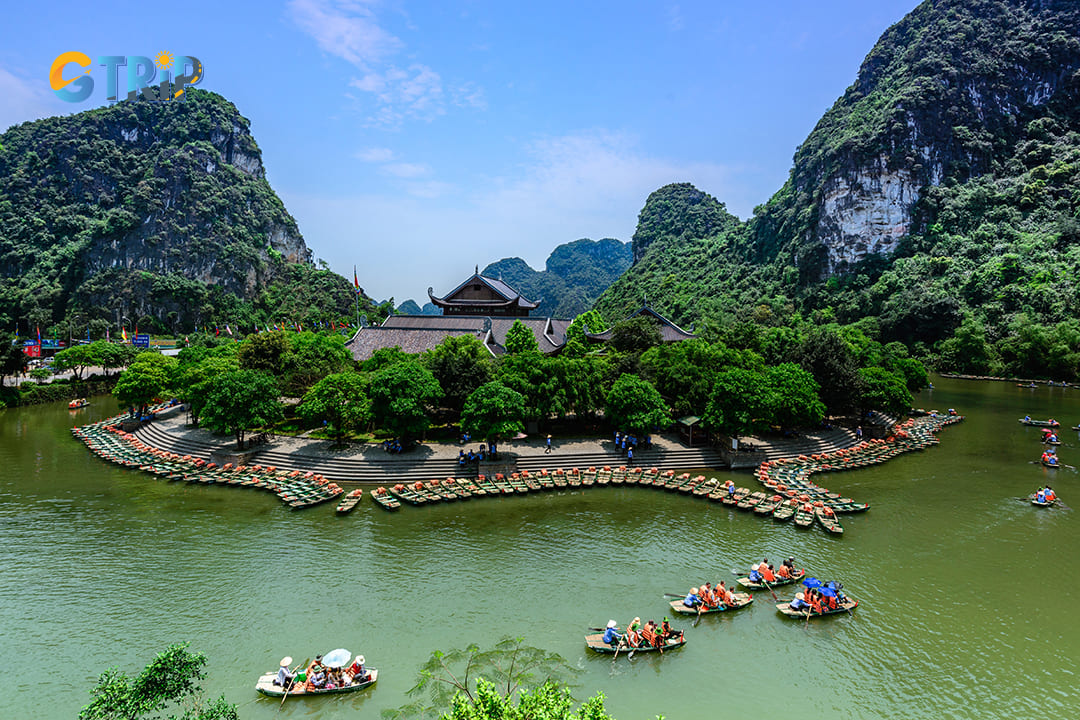
Trang An is always an ideal place for tourists visiting Ninh Binh
Thung Nang and local economy
Tourism in Sunny Valley supports the local economy by providing jobs, boosting income for small businesses, and promoting traditional crafts.
Local vendors and souvenirs
Tourism actively supports small, local businesses like souvenir shops, food stalls, and traditional craft stands. Artisans sell handmade crafts, souvenirs, and regional snacks, providing travelers with unique mementos and supporting livelihoods. These businesses preserve traditional skills while creating a steady source of income, as people contribute directly to the local economy by purchasing these authentic items.
Community involvement in tourism
Local communities are essential in managing the valley’s tourism operations. From rowing boats to guiding tours and maintaining trails, locals offer an authentic experience while creating job opportunities. Community-led tourism ensures income reaches local families and promotes cultural pride, allowing travelers to connect with people who intimately know the area. This involvement also helps create a tourism model that benefits locals in the long run.
The economic impact of tourism
Tourism plays a significant role in boosting Ninh Binh’s economy by drawing both domestic and international travelers. This steady influx of people creates economic stability for the region, supporting growth while raising awareness of the valley’s natural beauty. Balancing economic benefits with sustainability is a top priority. Local authorities and communities work together to manage environmental impacts and protect the region’s heritage.
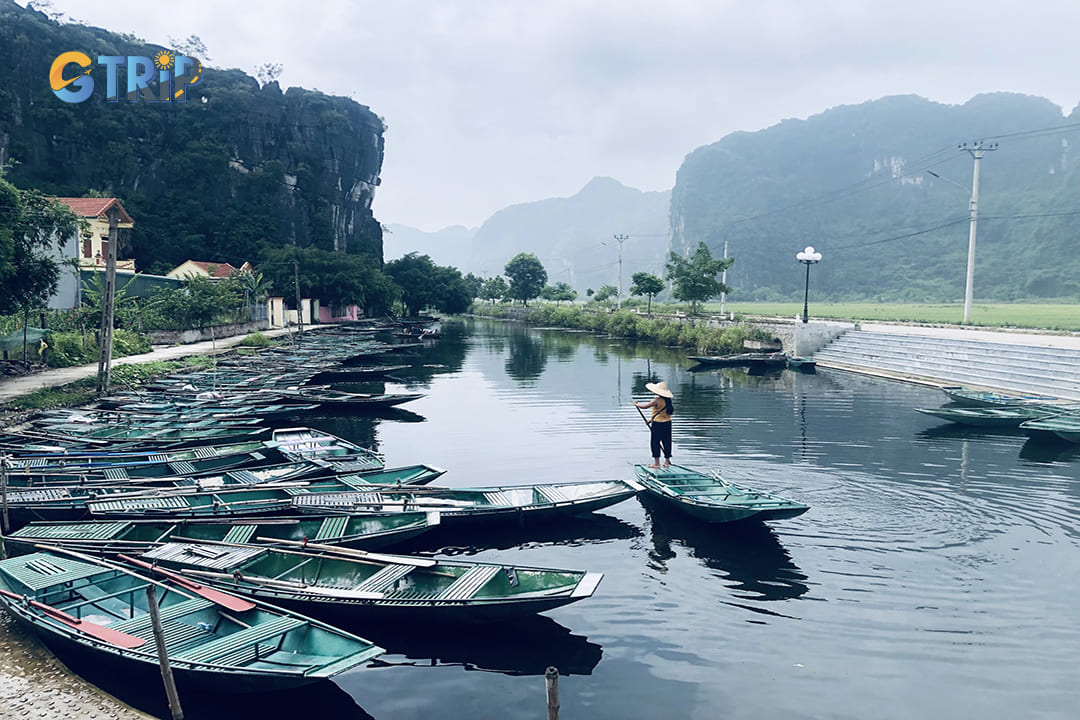
View of people making a living in Thung Nang on boats serving tourists
Sustainability and environmental impact
Tourism promotes sustainability by protecting local ecosystems and minimizing environmental impact. Conservation initiatives mitigate harm, ensuring that tourism positively influences the area’s natural beauty and wildlife.
Conservation efforts in Thung Nang
Conservation efforts in Thung Nang prioritize protecting its unique environment and habitat. Efforts focus on maintaining the area’s natural beauty, with eco-friendly building restrictions. Controlled development around limestone karsts, rivers, and rice fields is also implemented.
Local authorities protect native species and ecosystems, minimizing human disturbance by restricting certain areas during sensitive times, like breeding seasons. Travelers are advised not to disturb or feed wildlife, supporting the balance of ecosystems.
Government and local programs promote responsible tourism, including managing boat traffic to reduce erosion and training guides on conservation practices. These initiatives ensure tourism benefits the valley without harming its natural resources.
Locals actively participate in clean-up events and promote eco-friendly practices. This fosters a collective commitment to preserving landscapes and biodiversity for the future.
The impact of tourism
Tourism raises awareness of Thung Nang’s natural beauty but also strains the ecosystem. Increased foot traffic, boat tours, and waste can affect water quality, disturb wildlife, and cause erosion. Local authorities are working to manage these impacts by controlling the routes and encouraging eco-friendly practices.
Tourism has improved infrastructure, but increased waste and water use challenge ecological balance. Efforts to reduce plastic use and ensure proper waste disposal help mitigate environmental strain.
Tourism supports local jobs and businesses, providing a stable income for residents. However, it’s crucial to balance economic benefits with environmental protection to keep tourism sustainable.
Eco-tourism initiatives and conservation programs aim to protect beauty. This ensures tourism continues to benefit both the local economy and environment.

Join boat tours in Thung Nang to explore this place
Responsible tourism practices
To preserve Thung Nang’s natural beauty, responsible tourism practices are essential. Travelers are encouraged to respect the environment by staying on designated paths, minimizing noise, and disposing of waste properly. Simple actions, like refraining from littering and reducing plastic use, help maintain the area’s pristine condition.
Sunny Valley offers eco-tourism choices, such as no-plastic boat tours and community-based activities that support conservation. These experiences provide unique insights into the landscape while promoting sustainability. Opting for locally guided tours supports conservation efforts and ensures a lower environmental impact.
You can actively contribute to environmental protection by choosing tours that adhere to sustainable practices and avoiding activities that disrupt local wildlife. Responsible tourism not only enhances the experience but also helps sustain this beautiful area for the future.

